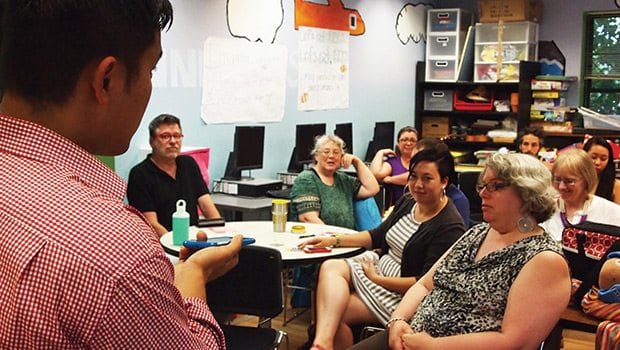Dot residents contemplate future of arts in neighborhood
Brainstorm arts ideas for Boston Creates

The Dorchester residents packed into a classroom at the Vietnamese American Community Center represent a cross section of the city’s most diverse neighborhood: black, Latino, white and Asian, young and old, brainstorming ideas about how to best enhance the local arts scene.
The musicians, visual artists and art lovers suggested cultural festivals in Ronan Park, more aggressive marketing for the Strand Theatre, more venues for live music.
The idea-sharing session was part of the city’s Boston Creates initiative, a 15-month effort aimed at enhancing the city’s arts scene.
“We want to develop a sustainable plan to make Boston a municipal arts leader,” said Joyce Linehan, chief of policy for the administration of Mayor Martin Walsh. “What that means will be borne out through the process.”
The effort is headed by Julie Burros, the city’s chief of Arts and Culture. Burros, who was out of town last week, was not available for an interview.
The planning process entails meetings, like the one in Dorchester last week, in every Boston neighborhood that are designed to give Boston residents the opportunity to shape the city’s arts policy. Linehan says the impetus for the program grew out of conversations Walsh had with arts advocates while campaigning for mayor. Philanthropic organizations including the Barr Foundation approached mayoral candidates seeking support for a city-wide arts plan.
Linehan herself was inspired by Summerthing, an initiative that brought public art and free concerts to the city’s neighborhoods during the administration of former Mayor Kevin White.
“Summerthing got me,” she said. “That was my first exposure to the arts.”
At the Vietnamese American Cultural Center, many of the arts-in-the-park concepts were similar to Summerthing programming. Other ideas, like changing zoning to facilitate more live music venues, reflect the modern reality of arts in Boston.
“We don’t have enough venues that aren’t controlled by Live Nation,” said David Dower, the artistic director at Arts Emerson.
Another modern reality that Dorchester meeting participants discussed was gentrification.
“There’s a shadow side to all these artistic endeavors,” said Sean Wheeler. “When you look at Porch Fest in J.P., it’s packaged to sell Jamaica Plain as the next great neighborhood. We need a recognition the creating cultural assets can have an undesired effect.”
Linehan said that as the city undergoes the development of the 53,000 units called for in the mayor’s housing plan, affordable housing, artist housing, studio spaces and venues can be incorporated into the plan.
“Part of this process is going to be what we call cultural asset mapping,” she said. “There has never been a complete inventory of all the spaces that could be used for art in Boston. It’s really important that with anything we’re building we’re looking at cultural spaces. ”
On the Web
For more information, visit: http://www.bostoncreates.org/
In the past, church buildings, like the Jorge Hernandez Cultural Center in the South End and cemeteries like the Forrest Hills Cemetery in Jamaica Plain are used for public and performing art.
The city is nearly half way through its neighborhood meetings, which will conclude in September. In October and November, city officials and contractors working on the project will analyze the responses they receive from the community conversations. By February, they will generate a draft cultural plan, which will be made available for community review. By June of next year, the plan will be completed.







